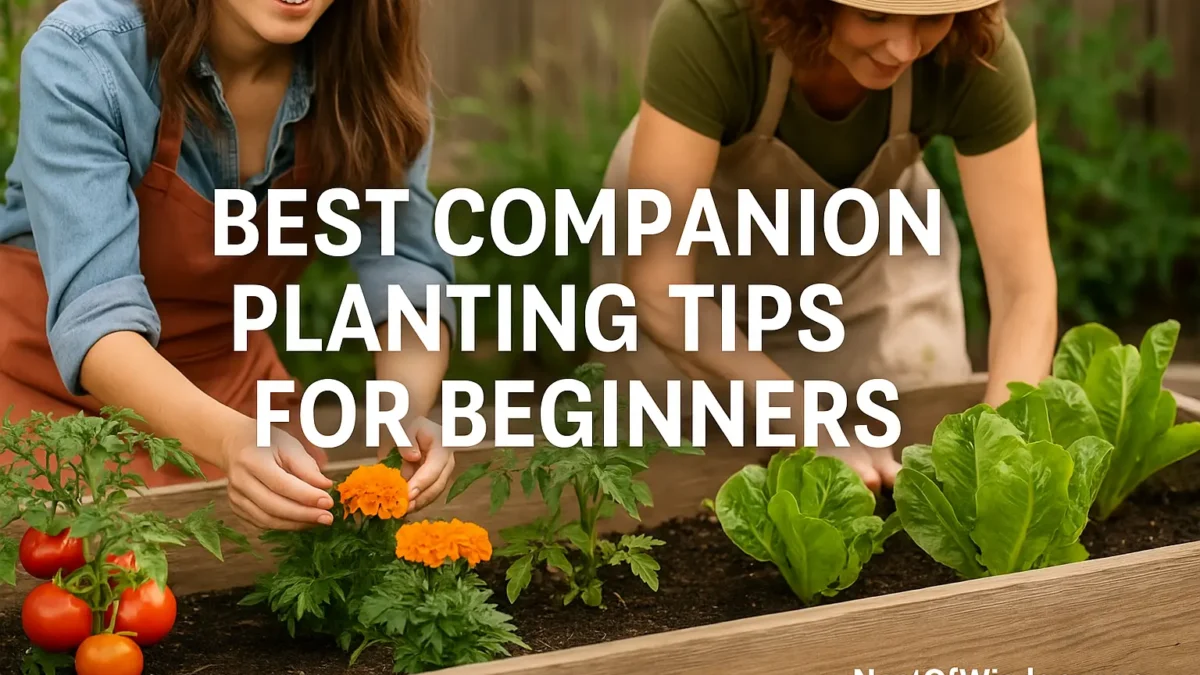Table of Contents
- Introduction
- What Is Companion Planting?
- Common Companion Table
- 11 Best Companion Planting Tips
- Tomatoes + Carrots
- Keep Tomatoes from Potatoes & Cucumbers
- Beans with Carrot & Lettuce
- Keep Beans from Onions/Garlic
- Potatoes + Cabbage + Beets
- Radish + Cabbage (Myth Buster)
- Marigolds as Protectors
- Peas with Turnips/Carrots (not Onions)
- Spinach + Strawberries
- Lettuce + Beets + Radish
- Nasturtiums as Trap Crops
- Bonus Tips
- FAQ
- Conclusion
✨ Introduction: Start With the Best Companion Planting Tips
Want more harvest with less chemicals? The smartest shortcut is learning a handful of best companion planting tips. Good plant neighbours share shade, invite pollinators, confuse pests, and keep soil lively—so you spend less time fighting problems and more time picking dinner.
உங்கள் வீட்டுத் தோட்டத்தில் best companion planting tips பின்பற்றினால் இயற்கையாகவே விளைச்சல் உயரும், பூச்சி தாக்குதல் குறையும். “நல்ல அயலான் நல்ல பயிர்”—இது செடிகளுக்கும் பொருந்தும்!
🌿 What Is Companion Planting?
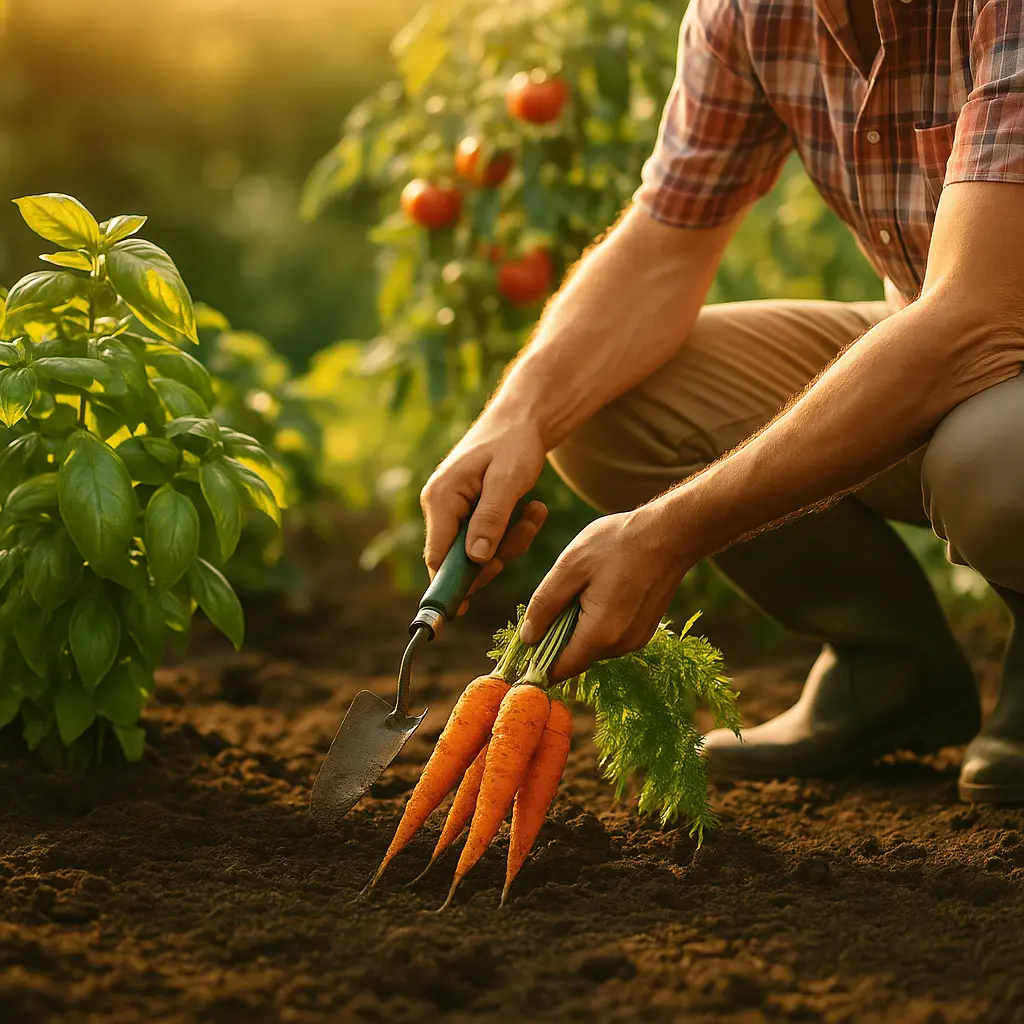

Companion planting is the practice of growing specific crops together for mutual benefits: pest control, better pollination, improved flavour, and efficient use of water, nutrients and space. For beginners, focusing on a few best companion planting tips prevents the classic mistakes—like pairing enemies or overcrowding beds.
🧠 Why Companion Planting Works (4 Keys)
- Smell & Signals: Aromatic plants (basil, marigold, nasturtium) mask host scents, attract pollinators, and call beneficial predators.
- Soil Nutrition: Legumes (beans/peas) host microbes that fix nitrogen. Nearby greens (lettuce/spinach) thrive with this gentle feed.
- Structure & Shade: Tall crops (tomato/corn) shelter shallow-rooted, shade-tolerant crops (carrot/beet/lettuce) that prefer cooler soil.
- Root Diversity: Deep roots open channels (carrot/beet); shallow roots harvest surface nutrients (lettuce/herbs). Less competition, better aeration.
Memorising these principles turns any garden plan into a list of best companion planting tips you can apply in minutes.
📋 Vegetable Companion Quick Guide
| Plant | Good Companions | Avoid These | Reason |
|---|---|---|---|
| Tomato | Basil, Carrot, Marigold | Potato, Corn, Cucumber | Shared blight; shade & airflow competition |
| Potato | Beans, Cabbage, Beets | Tomato, Cucumber | Disease overlap & sprawl issues |
| Beans | Carrot, Lettuce, Celery | Onion, Garlic, Leek | Alliums suppress N-fixing microbes |
| Carrot | Onion, Peas, Tomato | Dill (mature) | Alliums deter carrot fly; tomatoes give shade |
| Brassicas | Beets, Potato, Dill, Nasturtium | — | Mixed roots & trap crops reduce pests |
| Radish | Lettuce, Spinach, Cabbage | Grapevines | Trap crop for flea beetles/maggots |
| Peas | Carrot, Turnip | Onions/Garlic | Same allium conflict as beans |
| Beets | Cabbage, Lettuce, Onion | Pole Beans | Beans may stunt beets |
| Marigold | Most Veggies | — | Repels nematodes, draws helpers |
| Spinach | Strawberry, Radish | Potato (late shade) | Likes cool, moist microclimate |
🌱 11 Best Companion Planting Tips (Step-by-Step)
1) Tomatoes + Carrots (Classic Guild)
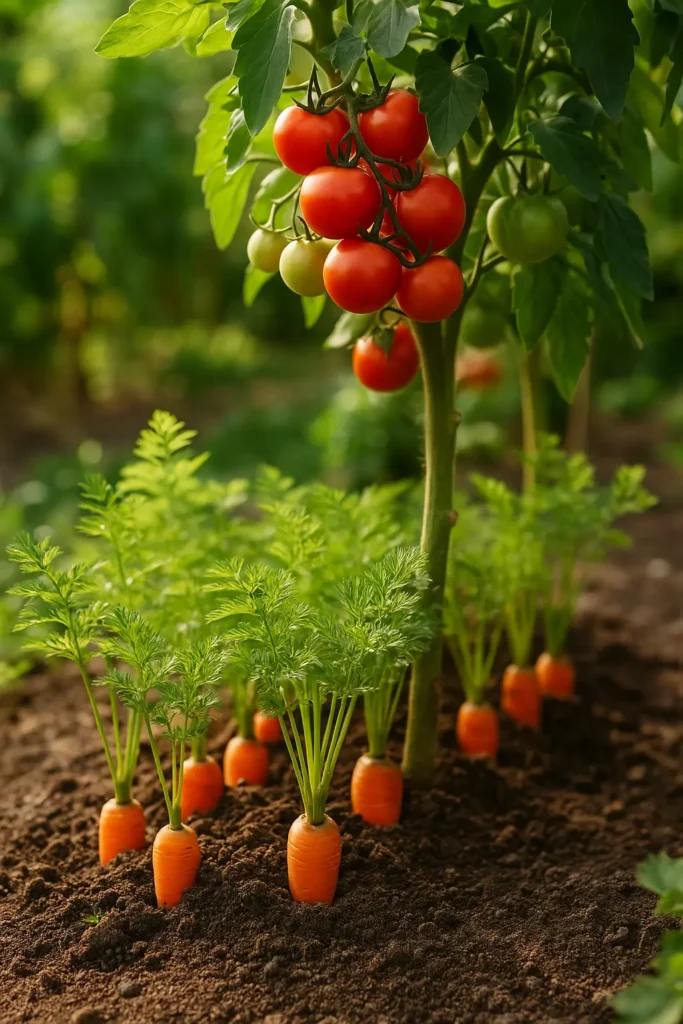

Why it works: Tomatoes provide dappled shade; carrots aerate soil and don’t compete near the surface.
Spacing: Tomatoes 45–60 cm apart; sow carrot ribbons 15 cm from stems.
Timing: Start carrots 2–3 weeks after transplanting tomatoes so seedlings aren’t shaded too early.
Do: Mulch lightly to keep carrot beds moist. Don’t: Overfeed nitrogen—leafy tops, tiny roots.
தமிழ் குறிப்புரை: “தக்காளி நிழலில் கேரட் இனிதாக வளர்கிறது.” A top entry in our best companion planting tips.
2) Keep Tomatoes Away From Potatoes & Cucumbers
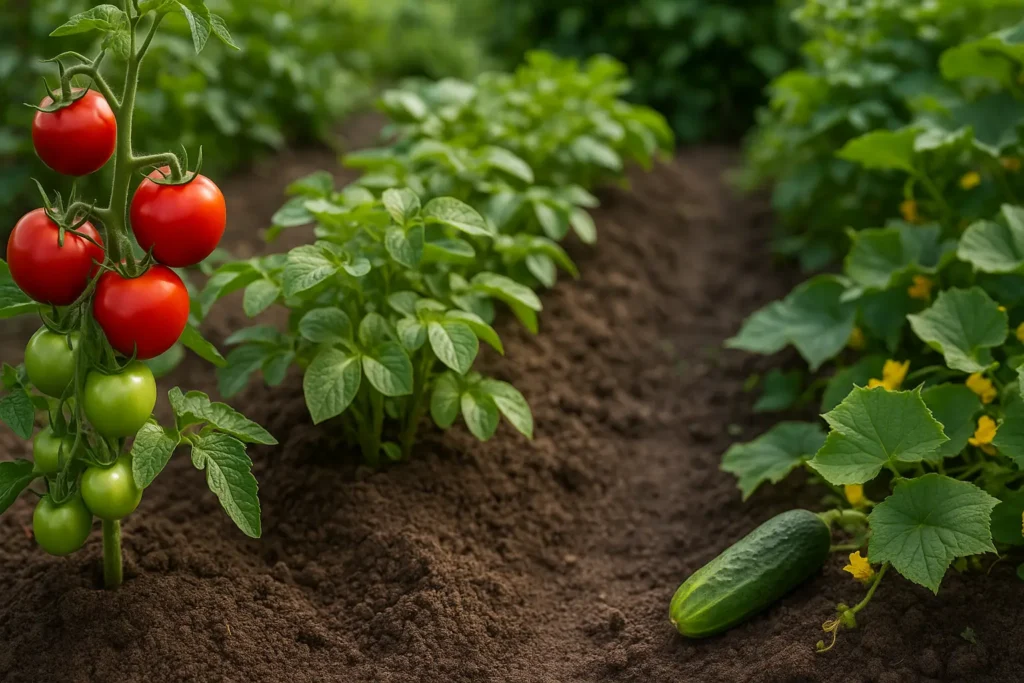

Why it works: Separating reduces blight risk (tomato↔potato) and improves airflow vs. sprawling cucumbers.
Spacing: Keep at least one full path (≥60–90 cm) or a separate bed between them.
Timing: If space is tight, stagger crops: early cucumbers; late tomatoes, or vice-versa.
Do: Edge with marigolds as a living buffer. Don’t: Overcrowd vines near tomatoes.
தமிழ் குறிப்புரை: “தொலைவு காத்தால் நோய் குறையும்.”
3) Beans Feed Carrot & Lettuce (Nitrogen Boost)
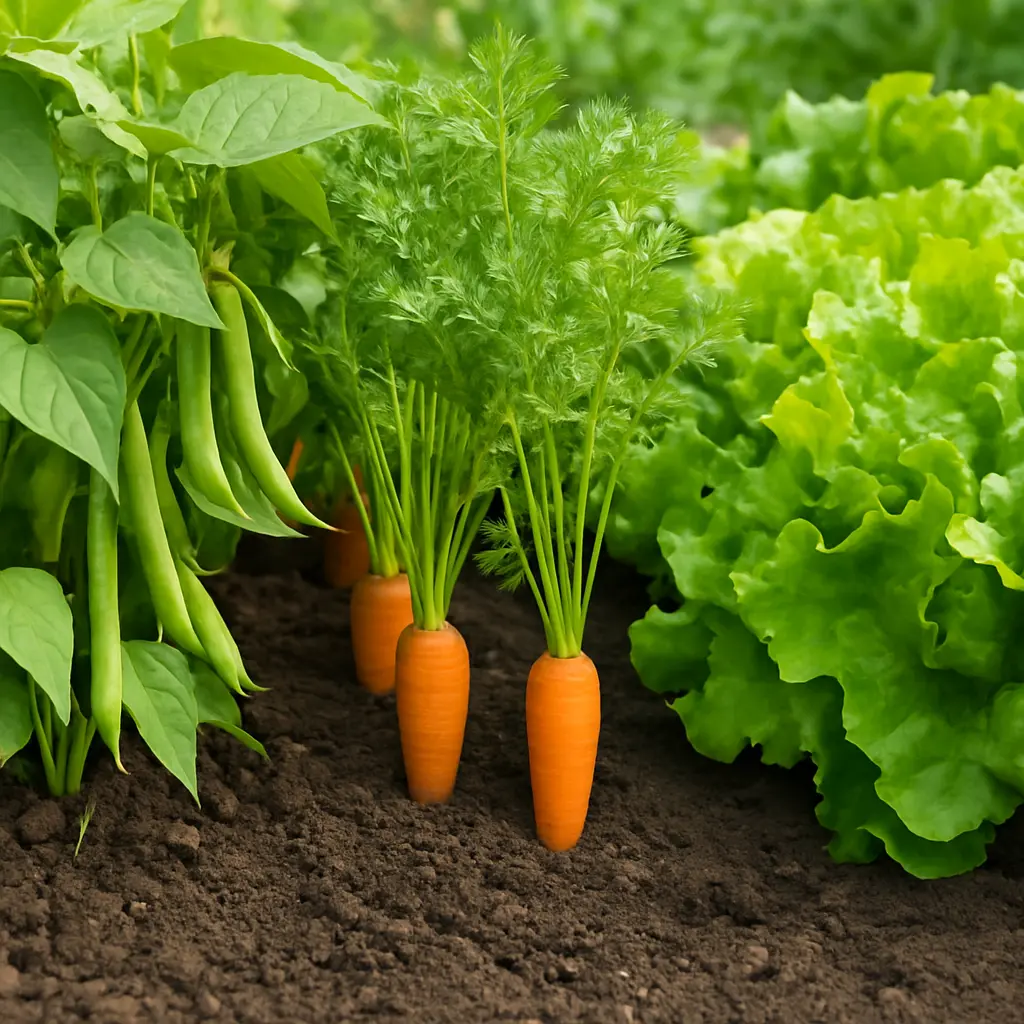

Why it works: Beans fix nitrogen; roots of carrot/lettuce sip the bonus without heavy fertiliser.
Spacing: Two bean rows 25–30 cm apart; carrot band between; lettuce 20–25 cm on south edge.
Timing: Transplant or sow beans first; add lettuce immediately; sow carrots 1–2 weeks later.
Do: Succession-sow lettuce every 2–3 weeks. Don’t: Shade young lettuce with tall stakes.
தமிழ் குறிப்புரை: “பீன்ஸ் வளர்க்கும்—சாலட் வளரும்.”
4) Keep Beans Away From Onions, Garlic & Leeks


Why it works: Alliums suppress nitrogen-fixing microbes on bean roots → poor growth.
Spacing: Different beds or at least a 60–90 cm gap.
Timing: If rotating, follow alliums with brassicas or roots, not beans immediately.
Do: Use sign markers to keep families apart. Don’t: Mix onion sets in bean rows.
தமிழ் குறிப்புரை: “வெங்காயம்–பீன்ஸ் பிரிந்து நில்.”
5) Potatoes + Cabbage + Beets (Harmony Row)


Why it works: Complementary roots and moisture needs; beets stay compact beside brassicas.
Spacing: Potatoes 30–40 cm; cabbage 45 cm; beets 20 cm; rows 45–60 cm apart.
Timing: Plant potatoes first; set cabbage transplants 1–2 weeks later; direct-sow beets after that.
Do: Mulch to cool soil. Don’t: Let potato foliage shade small cabbages—prune lower leaves.
தமிழ் குறிப்புரை: “மூன்றும் இணைந்து—மண் கலக்காது.”
6) Radish + Cabbage (Myth Buster Allies)
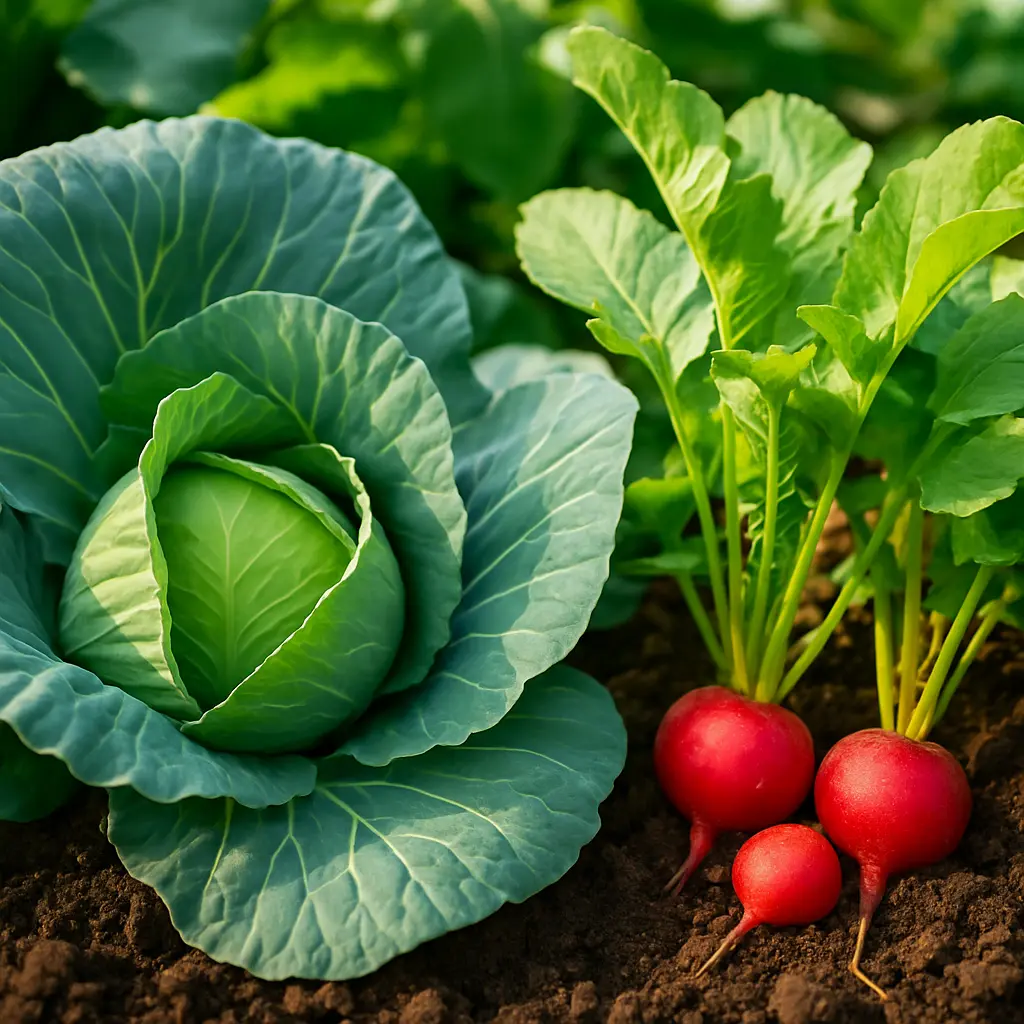

Why it works: Radish acts as a trap crop for flea beetles/cabbage maggots; harvest radish early.
Spacing: Cabbage 45 cm; sow radish 10–12 cm away between plants.
Timing: Sow radish at transplant; repeat every 2–3 weeks until heads size up.
Do: Thin radish promptly. Don’t: Leave over-mature radish to bolt and steal water.
தமிழ் குறிப்புரை: “முள்ளங்கி காவலன்—முட்டைக்கோசுக்கு.”
7) Marigolds: Universal Protectors


Why it works: Repels nematodes/aphids; attracts hoverflies and parasitoid wasps.
Spacing: Dwarf marigolds every 25–30 cm along bed edges and corners.
Timing: Set transplants as you plant main crops; deadhead for continuous bloom.
Do: Keep flowers sunny. Don’t: Shade young seedlings with tall varieties.
தமிழ் குறிப்புரை: “சாமந்தி சூழ்ந்தால் சுகமான தோட்டம்.”
8) Peas With Turnips/Carrots—Not Onions


Why it works: Alliums hinder pea microbes; turnip/carrot share space neatly under pea trellis.
Spacing: Trellis north side; sow peas 5 cm apart; turnips/carrots 10–15 cm apart at the base.
Timing: Sow peas early; add turnips/carrots a week later; pull turnips before pea vines tangle.
Do: Mulch the row base. Don’t: Interplant onions or garlic here.
தமிழ் குறிப்புரை: “பட்டாணி நண்பன்—நாவல்/கேரட்; வெங்காயம் இல்லை.”
9) Spinach + Strawberries (Cool-Soil Partners)


Why it works: Spinach acts as living mulch—shades soil, cuts weeds, holds moisture; berries enjoy cooler crowns.
Spacing: Strawberry rows 35–45 cm apart; sow spinach in a 15–20 cm ribbon between.
Timing: Interplant in cool seasons; replace spinach with parsley/basil as heat rises.
Do: Top-dress berries with compost. Don’t: Let spinach smother runners—trim as needed.
தமிழ் குறிப்புரை: “வாடாத மண்—இனிப்பு பழம்.”
10) Lettuce + Beets + Radish (Small-Space Trio)
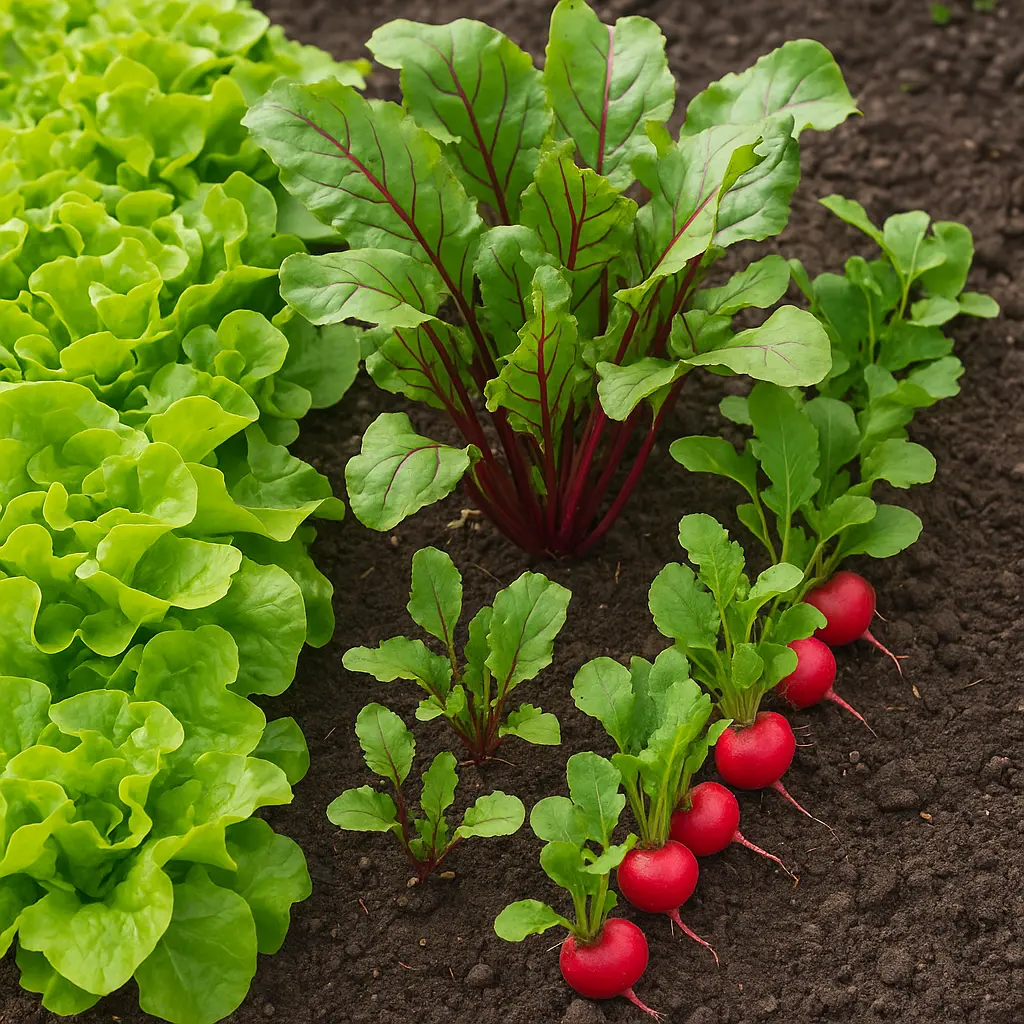

Why it works: Different harvest speeds keep beds productive—radish (3–4 wks), lettuce (4–6), beets (8–10).
Spacing: Beets 20 cm; lettuce 20–25 cm; radish 5–8 cm between.
Timing: Sow all together; harvest radish first, then lettuce; beets finish last.
Do: Re-sow radish in harvested gaps. Don’t: Overwater—beet roots may split.
தமிழ் குறிப்புரை: “சிறு இடம்—மூன்று பயன்.”
11) Nasturtiums as Trap Crops (Cukes, Squash, Beans)
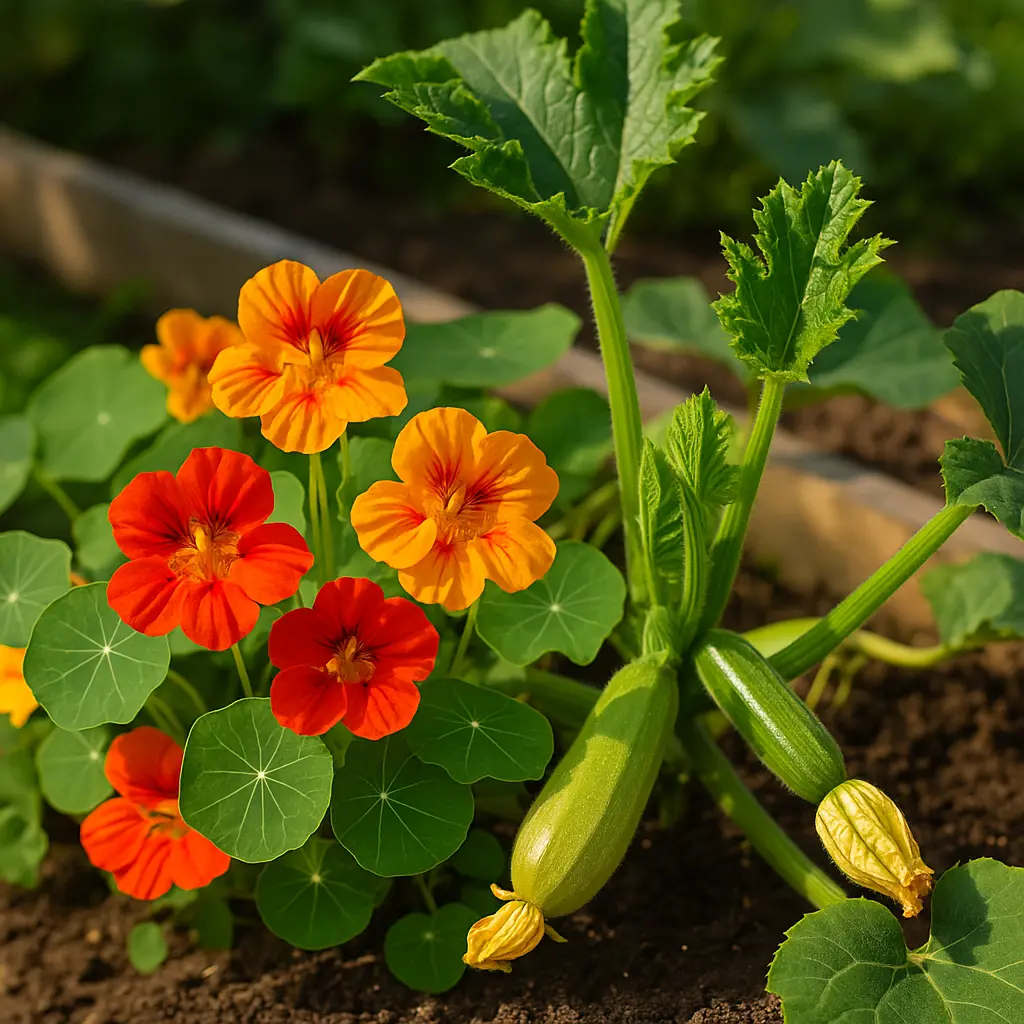

Why it works: Bright leaves/flowers lure aphids and flea beetles away from key crops.
Spacing: Plant nasturtiums 25–30 cm from cucumbers/squash/beans; dot along the outer edge.
Timing: Transplant at the same time as main crops; inspect weekly; prune or hose off clusters.
Do: Compost heavily infested trimmings. Don’t: Let trap plants overrun the bed—keep them to the edge.
தமிழ் குறிப்புரை: “மலர் ஈர்க்கும்—பூச்சி திசை திரும்பும்.”
Remember: Airflow + mulch + smart neighbours = the heart of the best companion planting tips.
How: Plant 30 cm from target crops; inspect weekly; hose off swarms or prune infested parts. Trap-cropping is one of the best companion planting tips for organic control.
Bonus mantra: “Airflow first, fertiliser second.” Adequate spacing and mulching out-perform most sprays—a core truth behind the best companion planting tips.
🗺️ Easy 4×8 Bed Layouts You Can Copy
- Tomato Guild: Two tomato rows (staked) with carrot ribbons between; basil on edges; marigolds at corners.
- Bean & Salad Bar: North side bush beans; centre carrot band; south side two lettuce rows. Keep onions elsewhere.
- Brassica Shield: Cabbage at 45 cm spacing; radish between; beet border; nasturtiums along the path.
- Pea Spring → Summer Swap: Early peas + turnips under trellis; after peas, switch to lettuce while cucumbers move to a separate, sunny bed.
🐞 Beneficial Insects & Helper Herbs (Power-Ups)
Companion planting shines when you recruit allies. Add these to supercharge your best companion planting tips:
- Hoverflies & Lacewings: Love alyssum, dill, coriander flowers; their larvae eat aphids like candy.
- Parasitic Wasps: Attracted by fennel, yarrow, and marigold; they patrol for caterpillars and whiteflies.
- Bees: Borage, basil, and calendula boost pollination for tomatoes, squash, and beans.
- Helper herbs (low maintenance): Thyme and oregano as scented groundcovers; rosemary for windbreaks; mint only in pots (it spreads!).
தமிழ் குறிப்பு: “மலர் இருந்தால் மளிகை நிரையும்”—பூச்சிகள் உதவும்போது விளைச்சல் அதிகரிக்கும்.
🪴 Best Companion Planting Tips for Containers & Balconies
- Tomato + Basil + Marigold (40–50L tub): Tomato centre, basil east side, dwarf marigold west side. Rotate the pot weekly for even sun.
- Chili + Spring Onion + Coriander (25–30L): Scents confuse pests; harvest greens continuously.
- Strawberry Trough + Spinach: Spinach as seasonal living mulch; swap to parsley in summer.
- Beans + Lettuce (deep box): Trellis at the back; lettuce at front edge where it stays cooler.
Container rule: Bigger soil volume = happier companions. Water deeply and mulch pots with coco chips or leaf mould.
⏱️ Seasonal & Succession Planner
- Early Spring: Peas + carrots; spinach with strawberries; radish between cabbage.
- Late Spring: Transplant tomatoes; sow carrots nearby; set marigold borders; start bush beans feeding lettuce.
- Monsoon/Wet: Prioritise airflow; prune lower tomato leaves; widen paths; avoid tomato-cucumber proximity.
- Late Season: After beans, switch to fast salad mixes; after onions, sow beets/carrots for fall.
இந்த best companion planting tips காலநிலைக்கு ஏற்ப சின்ன மாற்றங்களுடன் எல்லோருக்கும் வேலை செய்கின்றன.
🛠️ Troubleshooting & Common Mistakes
- Plants look leggy? Too much shade from tall neighbours. Re-stake or thin to restore light—one of the simplest best companion planting tips.
- Lots of leaves, tiny roots? Over-fertilising carrots/beets near beans. Ease nitrogen; add wood-chip mulch.
- Aphid hotspot on nasturtiums? Good! They’re working as trap crops. Blast with water, prune heavy clusters, compost the waste.
- Wilting at noon? Not always thirst—sometimes heat stress. Mulch, widen spacing, water at dawn.
- Same family, same bed every year? Rotate! Brassicas → roots → legumes → fruiting crops.
❓ FAQ – Best Companion Planting Tips
Q1. What are the best companion planting tips for tiny spaces?
Go vertical (peas/beans north trellis), use the lettuce + beet + radish trio, and ring beds with marigolds. Keep tomatoes far from potatoes/cucumbers to protect airflow.
Q2. Can tomatoes and cucumbers grow together?
Better to separate them. Cucumbers shade and humidify tomato foliage, increasing disease risk. Separate beds = fewer problems.
Q3. Why avoid onions near beans and peas?
Alliums release chemicals that suppress the nitrogen-fixing microbes legumes rely on—yield drops noticeably.
Q4. Are marigolds safe with most vegetables?
Yes. They repel nematodes/aphids and attract beneficials. Use dwarf types to avoid shading seedlings.
Q5. Do I still need compost and mulch?
Absolutely. The best companion planting tips work best in living, well-fed soil kept evenly moist with mulch.
Q6. What’s a beginner-proof monthly routine?
Week 1: Plan layouts and sow radish/greens. Week 2: Transplant tomatoes/basil; edge with marigolds. Week 3: Sow carrots between tomatoes; trellis peas/beans. Week 4: Mulch and note results in a garden diary.
🔗 Internal Links
- Grow Organic Vegetables at Home
- Top 10 Sacred Plants for Vastu
- 7 Low GI South Indian Meals
- 10 Best Millets and How to Cook Them
🔗 External Links
- University of Minnesota Extension – Companion planting in home gardens
- Oregon State University – Practice the good neighbor policy in the garden: try companion planting
- OSU Extension – Between the Rows: flowers & herbs for companion planting (quick companion list)
✅ Conclusion: Put the Best Companion Planting Tips to Work
Partnership beats pesticides. With these best companion planting tips—tomato + carrot guilds, bean-fed salad beds, marigold borders, and nasturtium trap crops—you’ll create a garden that resists pests, uses water wisely, and produces flavour-packed harvests. இன்று ஒரு ஜோடியை மட்டும் தொடங்குங்கள்; அடுத்த மாதம் இன்னொன்றைச் சேருங்கள். Observe → adjust → repeat. That rhythm turns beginners into confident growers.
Nest of Wisdom Insights is a dedicated editorial team focused on sharing timeless wisdom, natural healing remedies, spiritual practices, and practical life strategies. Our mission is to empower readers with trustworthy, well-researched guidance rooted in both Tamil culture and modern science.
இயற்கை வாழ்வு மற்றும் ஆன்மிகம் சார்ந்த அறிவு அனைவருக்கும் பயனளிக்க வேண்டும் என்பதே எங்கள் நோக்கம்.
- Nest of Wisdom Authorhttps://nestofwisdom.com/author/varakulangmail-com/
- Nest of Wisdom Authorhttps://nestofwisdom.com/author/varakulangmail-com/
- Nest of Wisdom Authorhttps://nestofwisdom.com/author/varakulangmail-com/
- Nest of Wisdom Authorhttps://nestofwisdom.com/author/varakulangmail-com/
Related posts
Today's pick
Recent Posts
- Internal Linking Strategy for Blogs: A Practical, Human-Centered Playbook
- AI in the Automotive Industry: A Practical, Human-Centered Guide
- Cloud Tools for Small Businesses and Freelancers: The Complete Guide
- Generative AI in Business: Real-World Use Cases, Benefits & Risks
- 7 Life-Changing Daily Habits for Weight Loss Without Dieting

